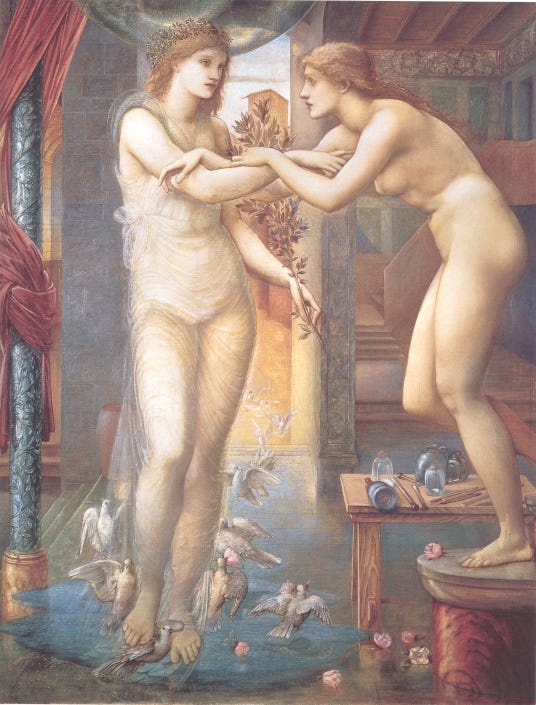A woman’s face with Nature’s own hand painted Hast thou, the master-mistress of my passion; A woman’s gentle heart, but not acquainted With shifting change, as is false women’s fashion; An eye more bright than theirs, less false in rolling, Gilding the object whereupon it gazeth; A man in hue, all “hues” in his controlling, Which steals men’s eyes and women’s souls amazeth. And for a woman wert thou first created; Till Nature, as she wrought thee, fell a-doting, And by addition me of thee defeated, By adding one thing to my purpose nothing. But since she prick’d thee out for women’s pleasure, Mine be thy love and thy love’s use their treasure.
What we love about this
Despite stock misogyny (‘false women’) and rough sexual puns (‘nothing’, ‘prick’) the sophistication of this sonnet is captivating. The male speaker addresses, in a tone of mock lament, a man who loves him. In the late medieval history of the sonnet form, it is conventional that a male speaker addresses a female beloved (who is often inaccessible or disinclined to the speaker—or both!). This is one of a number of Shakespearean sonnets addressed to a beautiful young man.
Referencing the Pygmalion myth, the speaker imagines that this man’s beauty and tenderness is because Nature once designed a woman whose sexual magnetism to all who saw her was so great that Nature changed her mind, making this woman into a man to satisfy her own desire (‘thy love’s use [women’s] treasure’). This quasi-complaint sonnet expresses how this lover’s body is constructed though that social convention, but it also suggests a plasticity in the way that humans are formed by nature. The clear passion between speaker and lover (‘Mine be thy love’) suggests that the ‘defeat’ of their connection is not absolute.
The pull of desire between creators and their creations leads us to think about the poem’s form here. Metre adds to the playful puns in this poem; by adding ‘feminine endings’ (an extra light syllable to the usual metre) in the iambic pentameter, Shakespeare references the ‘extra addition’ of the lover. Is this appendation an imperfection, or intrinsic to the beauty of both the lover and the poem?

About the Author
William Shakespeare (1564-1616) is most famous now for his plays, a large number of which were written or rewritten in collaboration with other writers (especially Thomas Middleton and John Fletcher). Shakespeare also wrote successful narrative poetry like Venus and Adonis (1593) and Lucrece (1594) in his period of direct pursuit of aristocratic patronage and courtly circles in the 1590s, during the closure of the London theatres (1592-1594).
His sonnets were also largely written from 1592 onwards, 154 of them published by Thomas Thorpe in 1609 (accompanied by A Lover’s Complaint); they were less immediately successful in Shakespeare’s lifetime, but have captivated readers in later centuries. By a convention set up in the first edition, these sonnets are often grouped into those dedicated to the ‘young man’ and those dedicated to the ‘dark lady’.
To Read Alongside
The Sonnets read well alongside Shakespeare’s plays, many of which include poems. In Act 3 of As You Like It, Fair Rosalind is the subject of Orlando’s love-sick poetry, which he hangs and carves on the trees of the Forest of Arden. Though he doesn’t know it yet, he will run into Rosalind again, this time in boy-mode (Ganymede).
The poetry of humanist Francesco Petrarca (Petrarch) (1304-1374), on his 21-year infatuation with Laura, was of enormous influence on courtly expression in the fifteenth and sixteenth centuries, and Shakespeare engages consciously with these older modes in his work.
Virginia Woolf’s novel Orlando (1928) begins in the Elizabethan court, and follows the life of handsome and magnetic poet Orlando, who travels across time and gender.
Ali Smith’s novel How to Be Both (2014) time-travels too, in the sense of juggling two simultaneously unfolding story lines, one featuring a modern-day teenage girl named George and the other focusing on the figure of Francesco del Cossa, an Italian Renaissance painter. The word ‘both’ in the title refers to being in two time periods and also ‘both’ genders.
In Detransition, Baby, Torrey Peters (2021) similarly explores creation, motherhood, and relationships in trans and cis lives in a novel that charts three interlinked characters and their past and current loves.



